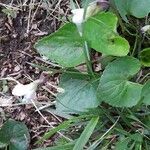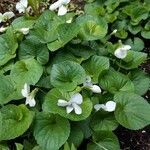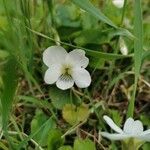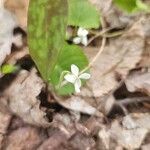Plants perennial, acaulescent, stoloniferous, 3–20 cm; stolons pale, often rooting and leafy at nodes; rhizome short, slender, fleshy. Leaves basal, 2–9, prostrate to ascending; stipules linear-lanceolate, margins entire, apex acute; petiole 2–11 cm, usually sparsely pubescent; blade unlobed, reniform to ovate, 2–4 × 2–4 cm, base cordate, lobes often overlapping, margins serrate, ciliate or eciliate, apex rounded or acute to acuminate, surfaces sometimes glabrous, usually sparsely pubescent adaxially. Peduncles 3–11 cm, glabrous or pubescent. Flowers: sepals lanceolate to ovate, lanceolate to ovate, margins mostly eciliate, auricles 1–2 mm; petals white on both surfaces, lower 3 purple-veined, lateral 2 usually beardless, lowest 8–10 mm, spur white, gibbous, 1–2 mm; style head beardless; cleistogamous flowers axillary. Capsules ovoid to ellipsoid, 4–6 mm, glabrous. Seeds beige to bronze, 1.5–2 mm. 2n = 44, 48.







